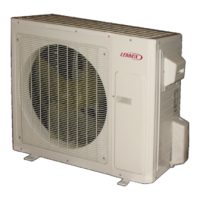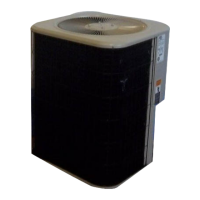15
If the outdoor unit is installed on eld-provided wall
mounting brackets, use lag bolts or equivalent to secure
the outdoor unit to the bracket. Minimum rear clearance
can be reduced to 6 inches (152 mm) when mounted
on brackets and with no obstructions on the other three
sides. Allow for condensate disposal when placing units
above one another.
Air Outlet
Air Inlet
6 in
152 mm
Figure 29.
Refrigerant Piping Connections
Line sets consists of two copper pipes connecting the
outdoor unit to the indoor unit. “Table 3. Refrigerant Piping
and Indoor Unit Connection Sizes” lists the connection
sizes. The connections are made using the provided brass
are nuts at the end of the refrigerant piping connections.
1. Choose the correct pipe sizes for your application
using “Table 3. Refrigerant Piping and Indoor Unit
Connection Sizes”.
2. Conrm that you are using the correct diameter piping.
3. Determine the necessary piping length required for the
application.
4. Cut the selected pipes with a pipe cutter. Make the
cuts at and smooth as illustrated in “Figure 30.
Cutting Pipe”.
Figure 30. Cutting Pipe
5. Insulate the copper piping.
6. Insert a are nut onto each pipe before aring.
7. Use “Table 2. Flaring Piping” to properly are the pipe.
Table 2. Flaring Piping
Pipe Diameter
Flare Dimension
Flare Shape
Min Max
1/4” (6.35) 8.3 8.7
R0.4~0.8
A
45
°
90°
4
-
+
3/8” (9.62) 12.0 12.4
1/2” (9.52” 15.4 15.8
5/8” (15.9) 18.6 19.1
3/4” (22.9) 22.9 23.3
8. After aring the pipe, temporarily sealed pipe ends with
adhesive tape to avoid contaminants from entering the
pipes.
9. The seal on the unit refrigerant piping connections
should remain in place until the last possible moment.
This will prevent dust or water from getting into the
refrigerant piping before it is connected.
10. CAREFULLY adjust refrigerant piping connections to
suit the application.
11. Slowly loosen one of the are nuts to release the
factory nitrogen charge from the indoor units only.
12. Remove the are nuts from the connections on the
unit and discard the seal from each of the piping
connections.
13. Slide the are nuts onto the ends of the eld-provided
refrigerant piping before using a suitable aring tool to
are the end of the copper pipe.
14. Apply recommended HFC-410A refrigerant lubricant
to the outside of the ared refrigerant lines.
IMPORTANT
The compressor in this unit contains PVE
oil (Polyvinylether). PVE oil is formulated for
hydrouorocarbon (HFC) refrigerants, such as HFC-
410A, which this system contains. While it may have
some miscibility properties with mineral-based oil and
POE oil (Polyolester), it is not recommended to mix PVE
oil with any other type of refrigerant oil.
15. Align the threaded connections with the
ared refrigerant lines. Tighten the are nuts
lightly at rst to obtain a smooth match as
illustrated in “Figure 31. Making Connections
(Male to Female Connection)”.
Table 3. Refrigerant Piping and Indoor Unit
Liquid Line
in.
Gas Line
in.
18000 1/4 1/2
